The Role of Training: Analysis of Human Resource Management Practices
VerifiedAdded on 2023/06/11
|11
|2920
|168
Essay
AI Summary
This essay provides a detailed analysis of how organizational learning and training processes impact costs in modern companies. It emphasizes that training and development should be a constant process, starting from an employee's first day, and should align with organizational goals. The essay discusses the importance of training for improving employee performance, organizational profitability, and overall competitiveness. It also explores budgeting methods for HR, including incremental and zero-based budgeting, and identifies key budget items like placement, training, compensation, and employee relations. Furthermore, the essay highlights the significance of managing training resources and budgets effectively to ensure employees have the necessary skills. The author shares personal experiences from their organization, suggesting the need for technological updates in training processes. The essay concludes that training and development programs should be tailored to employee needs and adapt to the changing business environment.
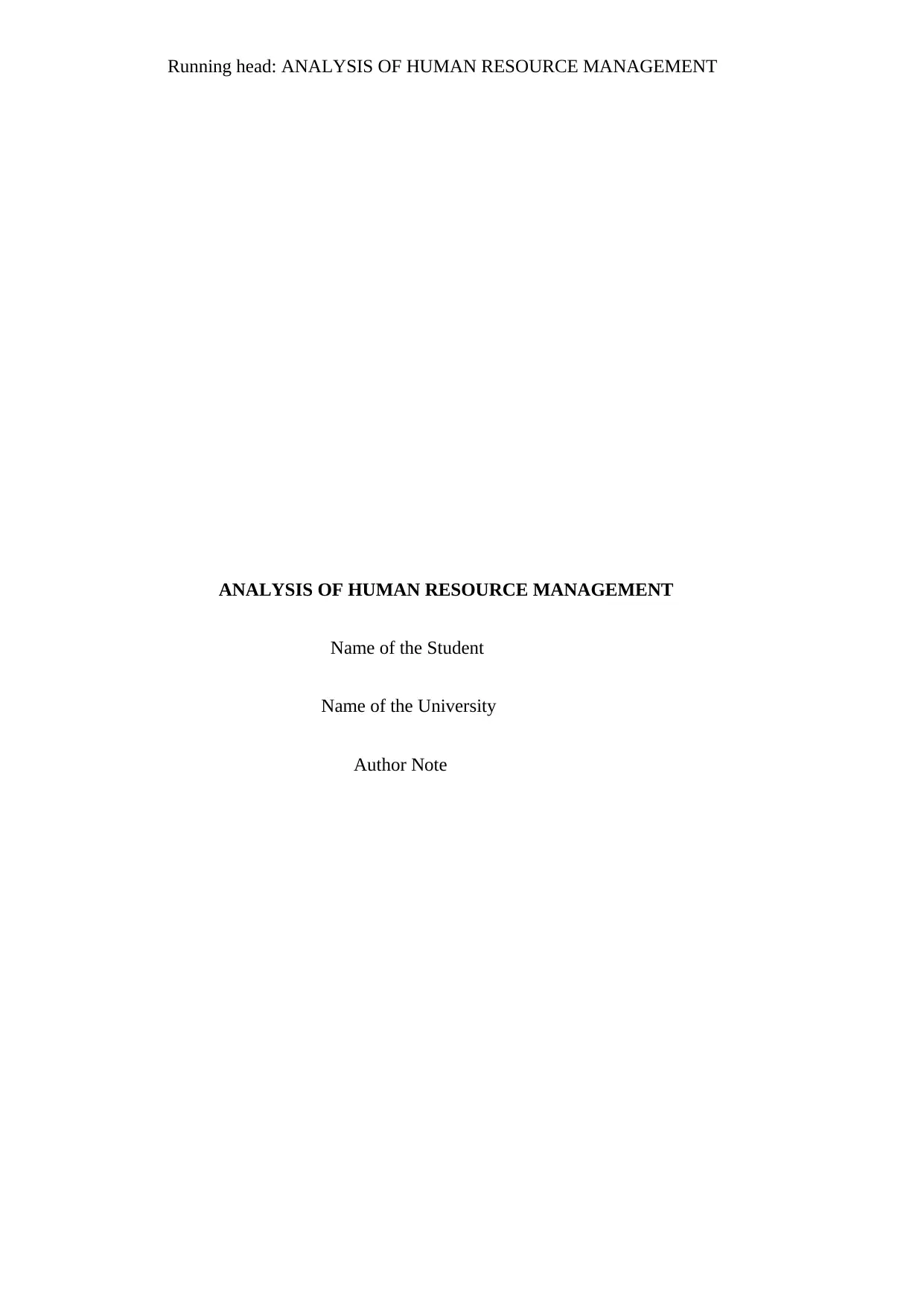
Running head: ANALYSIS OF HUMAN RESOURCE MANAGEMENT
ANALYSIS OF HUMAN RESOURCE MANAGEMENT
Name of the Student
Name of the University
Author Note
ANALYSIS OF HUMAN RESOURCE MANAGEMENT
Name of the Student
Name of the University
Author Note
Paraphrase This Document
Need a fresh take? Get an instant paraphrase of this document with our AI Paraphraser
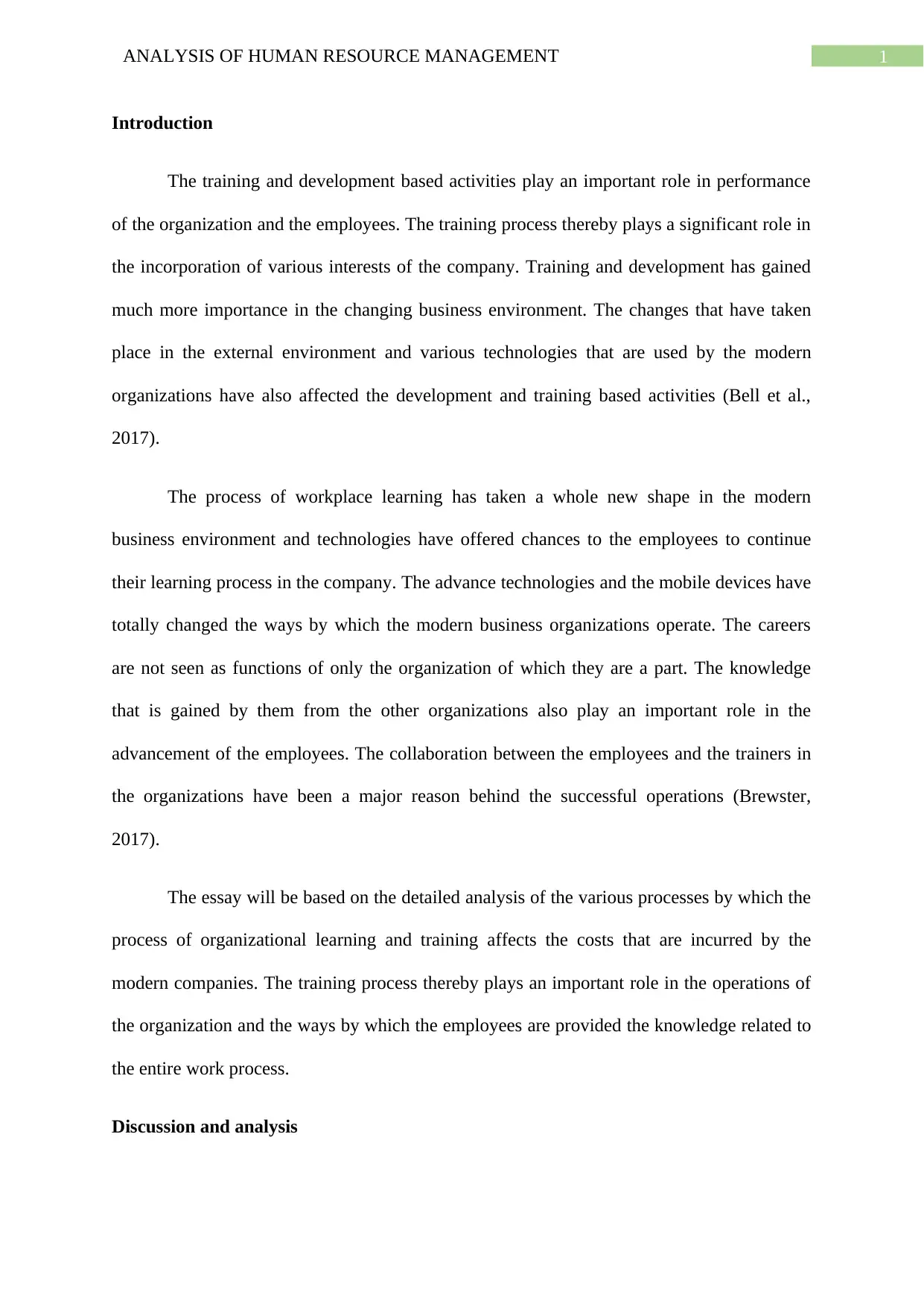
1ANALYSIS OF HUMAN RESOURCE MANAGEMENT
Introduction
The training and development based activities play an important role in performance
of the organization and the employees. The training process thereby plays a significant role in
the incorporation of various interests of the company. Training and development has gained
much more importance in the changing business environment. The changes that have taken
place in the external environment and various technologies that are used by the modern
organizations have also affected the development and training based activities (Bell et al.,
2017).
The process of workplace learning has taken a whole new shape in the modern
business environment and technologies have offered chances to the employees to continue
their learning process in the company. The advance technologies and the mobile devices have
totally changed the ways by which the modern business organizations operate. The careers
are not seen as functions of only the organization of which they are a part. The knowledge
that is gained by them from the other organizations also play an important role in the
advancement of the employees. The collaboration between the employees and the trainers in
the organizations have been a major reason behind the successful operations (Brewster,
2017).
The essay will be based on the detailed analysis of the various processes by which the
process of organizational learning and training affects the costs that are incurred by the
modern companies. The training process thereby plays an important role in the operations of
the organization and the ways by which the employees are provided the knowledge related to
the entire work process.
Discussion and analysis
Introduction
The training and development based activities play an important role in performance
of the organization and the employees. The training process thereby plays a significant role in
the incorporation of various interests of the company. Training and development has gained
much more importance in the changing business environment. The changes that have taken
place in the external environment and various technologies that are used by the modern
organizations have also affected the development and training based activities (Bell et al.,
2017).
The process of workplace learning has taken a whole new shape in the modern
business environment and technologies have offered chances to the employees to continue
their learning process in the company. The advance technologies and the mobile devices have
totally changed the ways by which the modern business organizations operate. The careers
are not seen as functions of only the organization of which they are a part. The knowledge
that is gained by them from the other organizations also play an important role in the
advancement of the employees. The collaboration between the employees and the trainers in
the organizations have been a major reason behind the successful operations (Brewster,
2017).
The essay will be based on the detailed analysis of the various processes by which the
process of organizational learning and training affects the costs that are incurred by the
modern companies. The training process thereby plays an important role in the operations of
the organization and the ways by which the employees are provided the knowledge related to
the entire work process.
Discussion and analysis
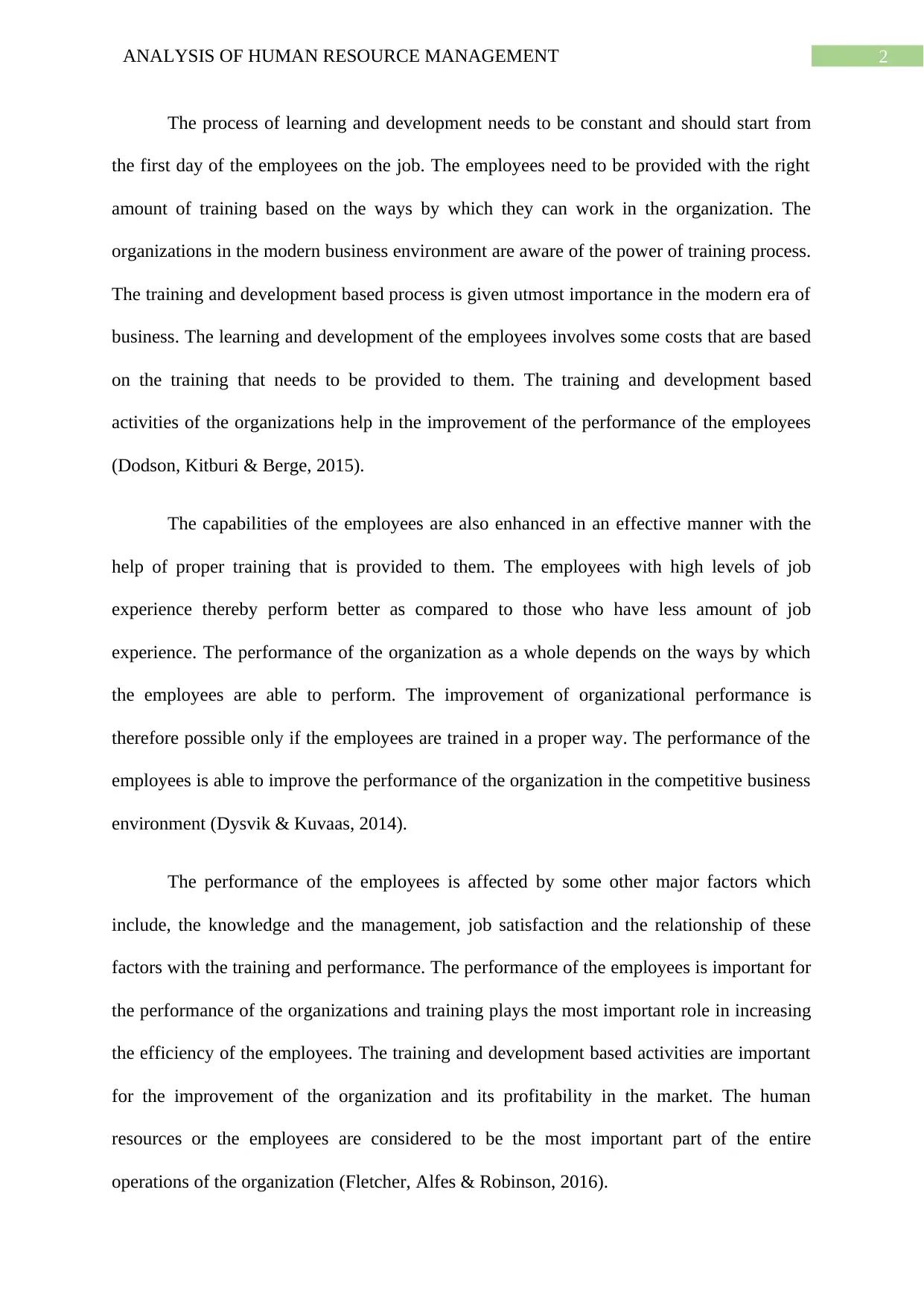
2ANALYSIS OF HUMAN RESOURCE MANAGEMENT
The process of learning and development needs to be constant and should start from
the first day of the employees on the job. The employees need to be provided with the right
amount of training based on the ways by which they can work in the organization. The
organizations in the modern business environment are aware of the power of training process.
The training and development based process is given utmost importance in the modern era of
business. The learning and development of the employees involves some costs that are based
on the training that needs to be provided to them. The training and development based
activities of the organizations help in the improvement of the performance of the employees
(Dodson, Kitburi & Berge, 2015).
The capabilities of the employees are also enhanced in an effective manner with the
help of proper training that is provided to them. The employees with high levels of job
experience thereby perform better as compared to those who have less amount of job
experience. The performance of the organization as a whole depends on the ways by which
the employees are able to perform. The improvement of organizational performance is
therefore possible only if the employees are trained in a proper way. The performance of the
employees is able to improve the performance of the organization in the competitive business
environment (Dysvik & Kuvaas, 2014).
The performance of the employees is affected by some other major factors which
include, the knowledge and the management, job satisfaction and the relationship of these
factors with the training and performance. The performance of the employees is important for
the performance of the organizations and training plays the most important role in increasing
the efficiency of the employees. The training and development based activities are important
for the improvement of the organization and its profitability in the market. The human
resources or the employees are considered to be the most important part of the entire
operations of the organization (Fletcher, Alfes & Robinson, 2016).
The process of learning and development needs to be constant and should start from
the first day of the employees on the job. The employees need to be provided with the right
amount of training based on the ways by which they can work in the organization. The
organizations in the modern business environment are aware of the power of training process.
The training and development based process is given utmost importance in the modern era of
business. The learning and development of the employees involves some costs that are based
on the training that needs to be provided to them. The training and development based
activities of the organizations help in the improvement of the performance of the employees
(Dodson, Kitburi & Berge, 2015).
The capabilities of the employees are also enhanced in an effective manner with the
help of proper training that is provided to them. The employees with high levels of job
experience thereby perform better as compared to those who have less amount of job
experience. The performance of the organization as a whole depends on the ways by which
the employees are able to perform. The improvement of organizational performance is
therefore possible only if the employees are trained in a proper way. The performance of the
employees is able to improve the performance of the organization in the competitive business
environment (Dysvik & Kuvaas, 2014).
The performance of the employees is affected by some other major factors which
include, the knowledge and the management, job satisfaction and the relationship of these
factors with the training and performance. The performance of the employees is important for
the performance of the organizations and training plays the most important role in increasing
the efficiency of the employees. The training and development based activities are important
for the improvement of the organization and its profitability in the market. The human
resources or the employees are considered to be the most important part of the entire
operations of the organization (Fletcher, Alfes & Robinson, 2016).
⊘ This is a preview!⊘
Do you want full access?
Subscribe today to unlock all pages.

Trusted by 1+ million students worldwide
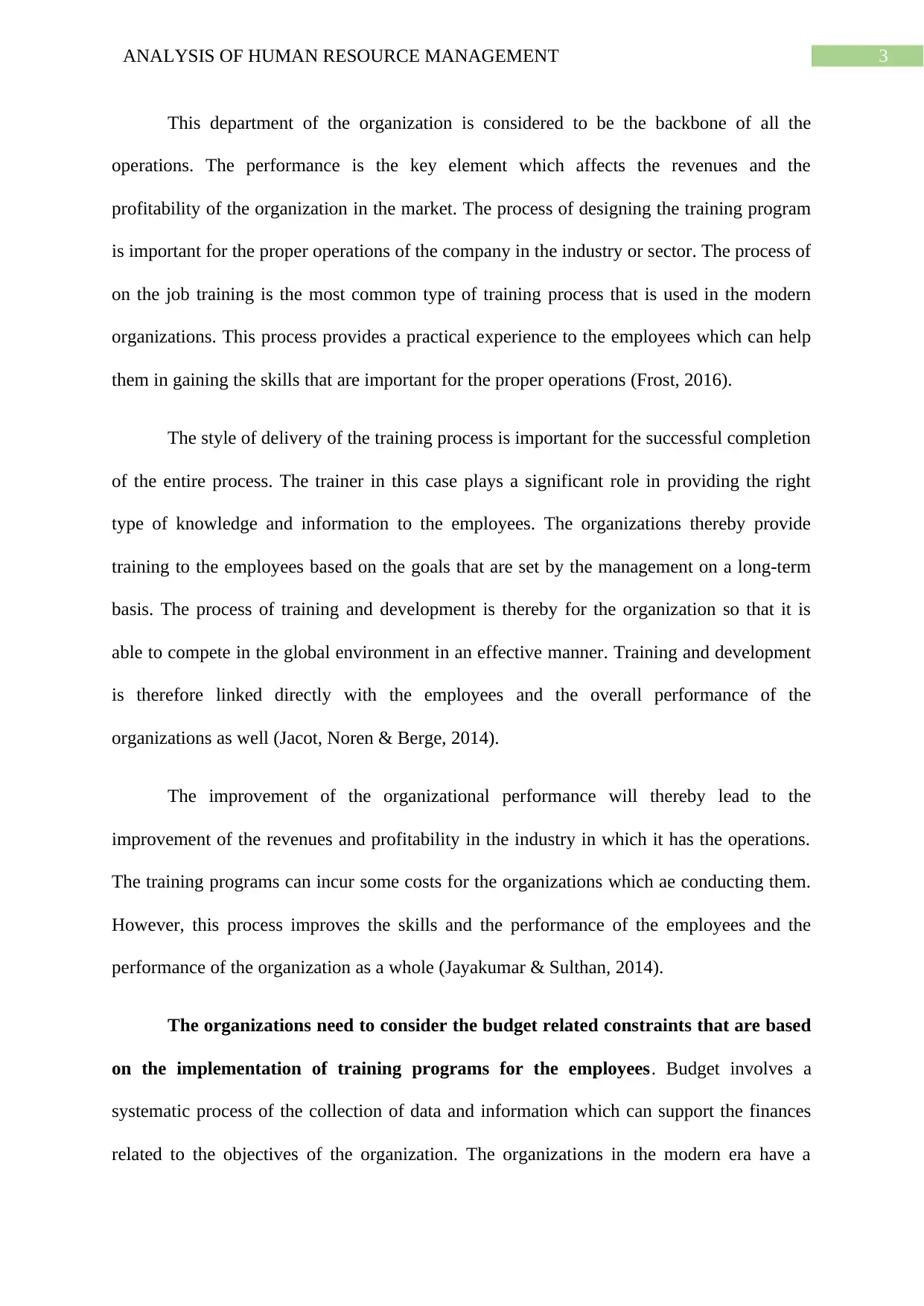
3ANALYSIS OF HUMAN RESOURCE MANAGEMENT
This department of the organization is considered to be the backbone of all the
operations. The performance is the key element which affects the revenues and the
profitability of the organization in the market. The process of designing the training program
is important for the proper operations of the company in the industry or sector. The process of
on the job training is the most common type of training process that is used in the modern
organizations. This process provides a practical experience to the employees which can help
them in gaining the skills that are important for the proper operations (Frost, 2016).
The style of delivery of the training process is important for the successful completion
of the entire process. The trainer in this case plays a significant role in providing the right
type of knowledge and information to the employees. The organizations thereby provide
training to the employees based on the goals that are set by the management on a long-term
basis. The process of training and development is thereby for the organization so that it is
able to compete in the global environment in an effective manner. Training and development
is therefore linked directly with the employees and the overall performance of the
organizations as well (Jacot, Noren & Berge, 2014).
The improvement of the organizational performance will thereby lead to the
improvement of the revenues and profitability in the industry in which it has the operations.
The training programs can incur some costs for the organizations which ae conducting them.
However, this process improves the skills and the performance of the employees and the
performance of the organization as a whole (Jayakumar & Sulthan, 2014).
The organizations need to consider the budget related constraints that are based
on the implementation of training programs for the employees. Budget involves a
systematic process of the collection of data and information which can support the finances
related to the objectives of the organization. The organizations in the modern era have a
This department of the organization is considered to be the backbone of all the
operations. The performance is the key element which affects the revenues and the
profitability of the organization in the market. The process of designing the training program
is important for the proper operations of the company in the industry or sector. The process of
on the job training is the most common type of training process that is used in the modern
organizations. This process provides a practical experience to the employees which can help
them in gaining the skills that are important for the proper operations (Frost, 2016).
The style of delivery of the training process is important for the successful completion
of the entire process. The trainer in this case plays a significant role in providing the right
type of knowledge and information to the employees. The organizations thereby provide
training to the employees based on the goals that are set by the management on a long-term
basis. The process of training and development is thereby for the organization so that it is
able to compete in the global environment in an effective manner. Training and development
is therefore linked directly with the employees and the overall performance of the
organizations as well (Jacot, Noren & Berge, 2014).
The improvement of the organizational performance will thereby lead to the
improvement of the revenues and profitability in the industry in which it has the operations.
The training programs can incur some costs for the organizations which ae conducting them.
However, this process improves the skills and the performance of the employees and the
performance of the organization as a whole (Jayakumar & Sulthan, 2014).
The organizations need to consider the budget related constraints that are based
on the implementation of training programs for the employees. Budget involves a
systematic process of the collection of data and information which can support the finances
related to the objectives of the organization. The organizations in the modern era have a
Paraphrase This Document
Need a fresh take? Get an instant paraphrase of this document with our AI Paraphraser
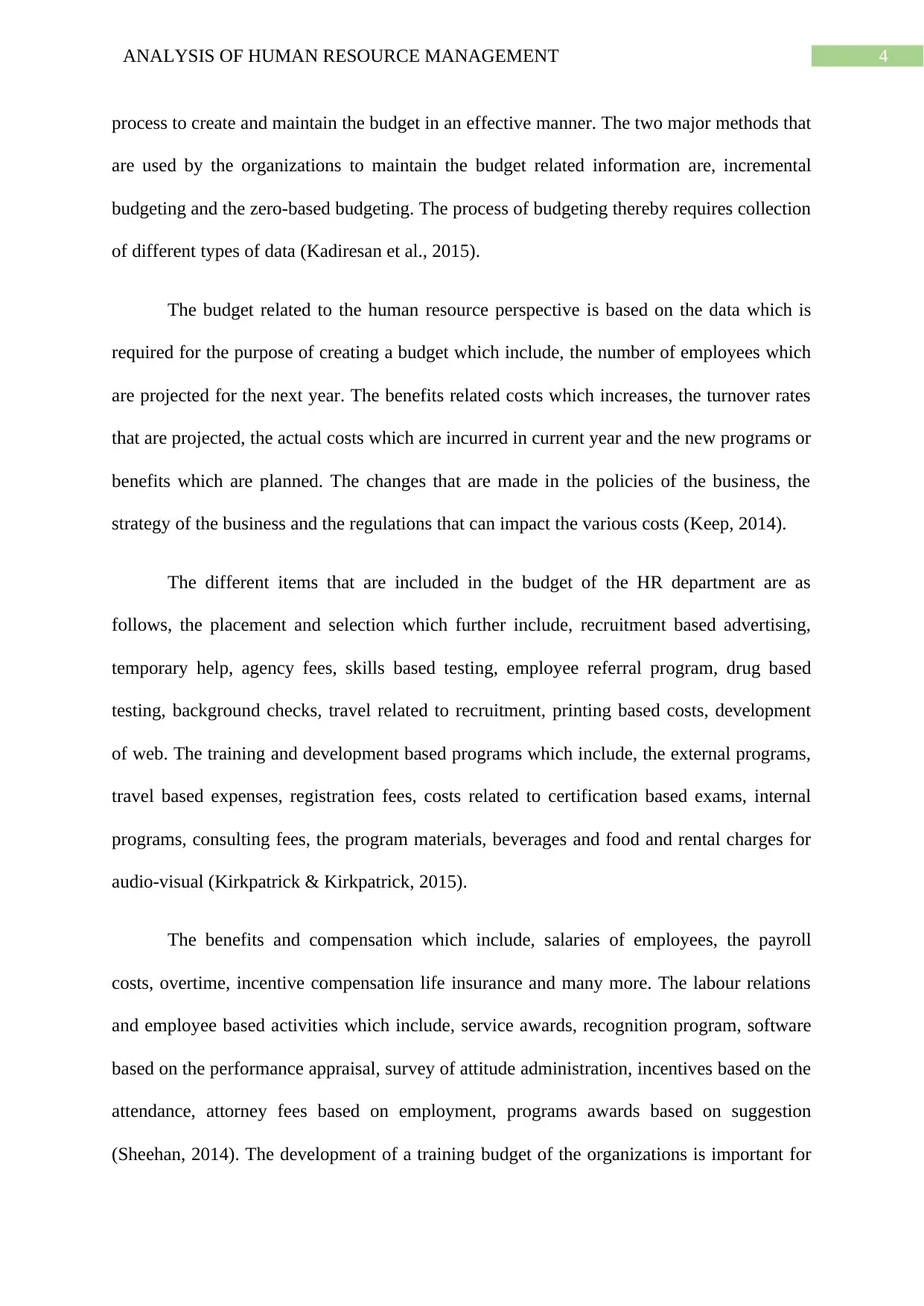
4ANALYSIS OF HUMAN RESOURCE MANAGEMENT
process to create and maintain the budget in an effective manner. The two major methods that
are used by the organizations to maintain the budget related information are, incremental
budgeting and the zero-based budgeting. The process of budgeting thereby requires collection
of different types of data (Kadiresan et al., 2015).
The budget related to the human resource perspective is based on the data which is
required for the purpose of creating a budget which include, the number of employees which
are projected for the next year. The benefits related costs which increases, the turnover rates
that are projected, the actual costs which are incurred in current year and the new programs or
benefits which are planned. The changes that are made in the policies of the business, the
strategy of the business and the regulations that can impact the various costs (Keep, 2014).
The different items that are included in the budget of the HR department are as
follows, the placement and selection which further include, recruitment based advertising,
temporary help, agency fees, skills based testing, employee referral program, drug based
testing, background checks, travel related to recruitment, printing based costs, development
of web. The training and development based programs which include, the external programs,
travel based expenses, registration fees, costs related to certification based exams, internal
programs, consulting fees, the program materials, beverages and food and rental charges for
audio-visual (Kirkpatrick & Kirkpatrick, 2015).
The benefits and compensation which include, salaries of employees, the payroll
costs, overtime, incentive compensation life insurance and many more. The labour relations
and employee based activities which include, service awards, recognition program, software
based on the performance appraisal, survey of attitude administration, incentives based on the
attendance, attorney fees based on employment, programs awards based on suggestion
(Sheehan, 2014). The development of a training budget of the organizations is important for
process to create and maintain the budget in an effective manner. The two major methods that
are used by the organizations to maintain the budget related information are, incremental
budgeting and the zero-based budgeting. The process of budgeting thereby requires collection
of different types of data (Kadiresan et al., 2015).
The budget related to the human resource perspective is based on the data which is
required for the purpose of creating a budget which include, the number of employees which
are projected for the next year. The benefits related costs which increases, the turnover rates
that are projected, the actual costs which are incurred in current year and the new programs or
benefits which are planned. The changes that are made in the policies of the business, the
strategy of the business and the regulations that can impact the various costs (Keep, 2014).
The different items that are included in the budget of the HR department are as
follows, the placement and selection which further include, recruitment based advertising,
temporary help, agency fees, skills based testing, employee referral program, drug based
testing, background checks, travel related to recruitment, printing based costs, development
of web. The training and development based programs which include, the external programs,
travel based expenses, registration fees, costs related to certification based exams, internal
programs, consulting fees, the program materials, beverages and food and rental charges for
audio-visual (Kirkpatrick & Kirkpatrick, 2015).
The benefits and compensation which include, salaries of employees, the payroll
costs, overtime, incentive compensation life insurance and many more. The labour relations
and employee based activities which include, service awards, recognition program, software
based on the performance appraisal, survey of attitude administration, incentives based on the
attendance, attorney fees based on employment, programs awards based on suggestion
(Sheehan, 2014). The development of a training budget of the organizations is important for
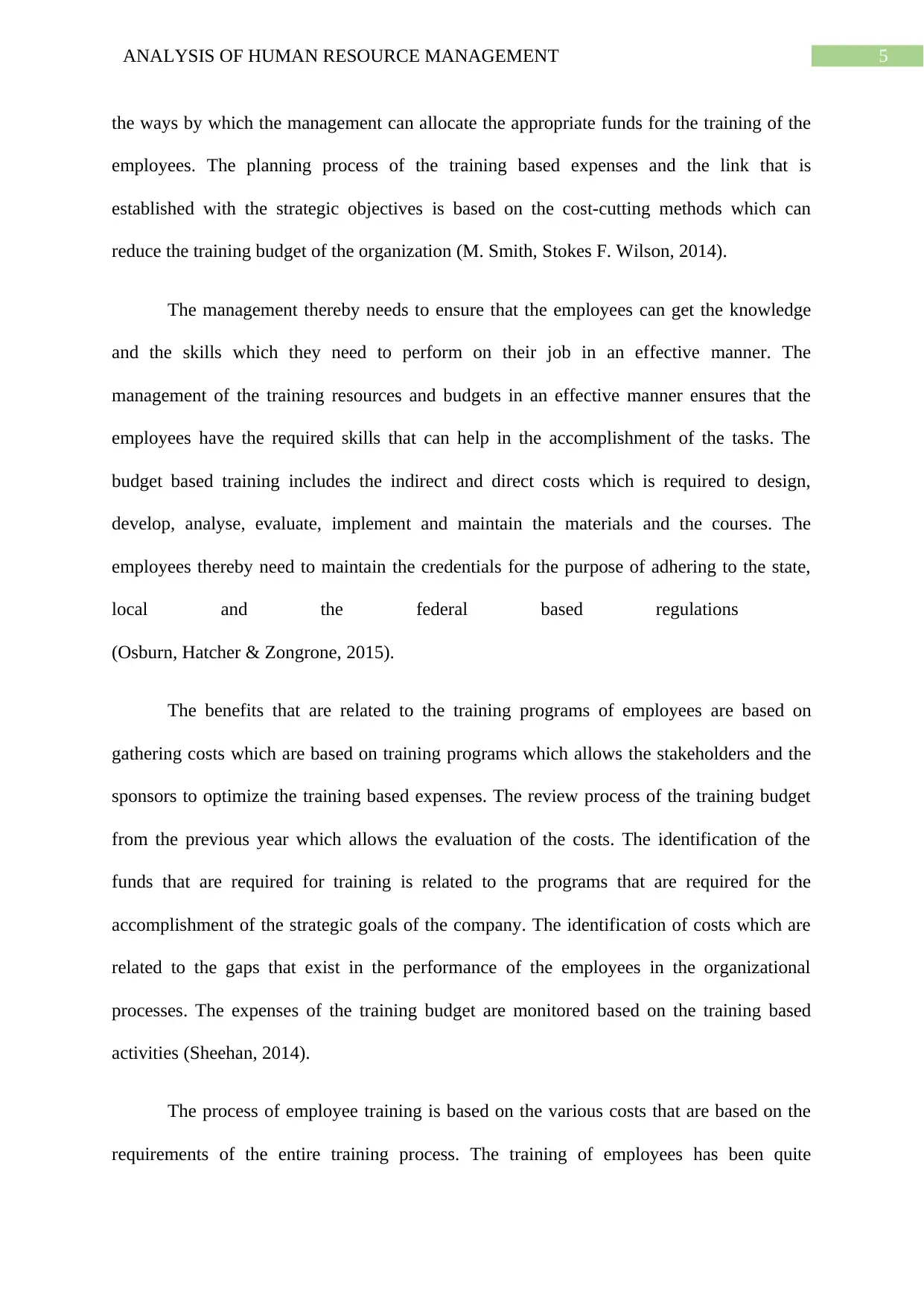
5ANALYSIS OF HUMAN RESOURCE MANAGEMENT
the ways by which the management can allocate the appropriate funds for the training of the
employees. The planning process of the training based expenses and the link that is
established with the strategic objectives is based on the cost-cutting methods which can
reduce the training budget of the organization (M. Smith, Stokes F. Wilson, 2014).
The management thereby needs to ensure that the employees can get the knowledge
and the skills which they need to perform on their job in an effective manner. The
management of the training resources and budgets in an effective manner ensures that the
employees have the required skills that can help in the accomplishment of the tasks. The
budget based training includes the indirect and direct costs which is required to design,
develop, analyse, evaluate, implement and maintain the materials and the courses. The
employees thereby need to maintain the credentials for the purpose of adhering to the state,
local and the federal based regulations
(Osburn, Hatcher & Zongrone, 2015).
The benefits that are related to the training programs of employees are based on
gathering costs which are based on training programs which allows the stakeholders and the
sponsors to optimize the training based expenses. The review process of the training budget
from the previous year which allows the evaluation of the costs. The identification of the
funds that are required for training is related to the programs that are required for the
accomplishment of the strategic goals of the company. The identification of costs which are
related to the gaps that exist in the performance of the employees in the organizational
processes. The expenses of the training budget are monitored based on the training based
activities (Sheehan, 2014).
The process of employee training is based on the various costs that are based on the
requirements of the entire training process. The training of employees has been quite
the ways by which the management can allocate the appropriate funds for the training of the
employees. The planning process of the training based expenses and the link that is
established with the strategic objectives is based on the cost-cutting methods which can
reduce the training budget of the organization (M. Smith, Stokes F. Wilson, 2014).
The management thereby needs to ensure that the employees can get the knowledge
and the skills which they need to perform on their job in an effective manner. The
management of the training resources and budgets in an effective manner ensures that the
employees have the required skills that can help in the accomplishment of the tasks. The
budget based training includes the indirect and direct costs which is required to design,
develop, analyse, evaluate, implement and maintain the materials and the courses. The
employees thereby need to maintain the credentials for the purpose of adhering to the state,
local and the federal based regulations
(Osburn, Hatcher & Zongrone, 2015).
The benefits that are related to the training programs of employees are based on
gathering costs which are based on training programs which allows the stakeholders and the
sponsors to optimize the training based expenses. The review process of the training budget
from the previous year which allows the evaluation of the costs. The identification of the
funds that are required for training is related to the programs that are required for the
accomplishment of the strategic goals of the company. The identification of costs which are
related to the gaps that exist in the performance of the employees in the organizational
processes. The expenses of the training budget are monitored based on the training based
activities (Sheehan, 2014).
The process of employee training is based on the various costs that are based on the
requirements of the entire training process. The training of employees has been quite
⊘ This is a preview!⊘
Do you want full access?
Subscribe today to unlock all pages.

Trusted by 1+ million students worldwide
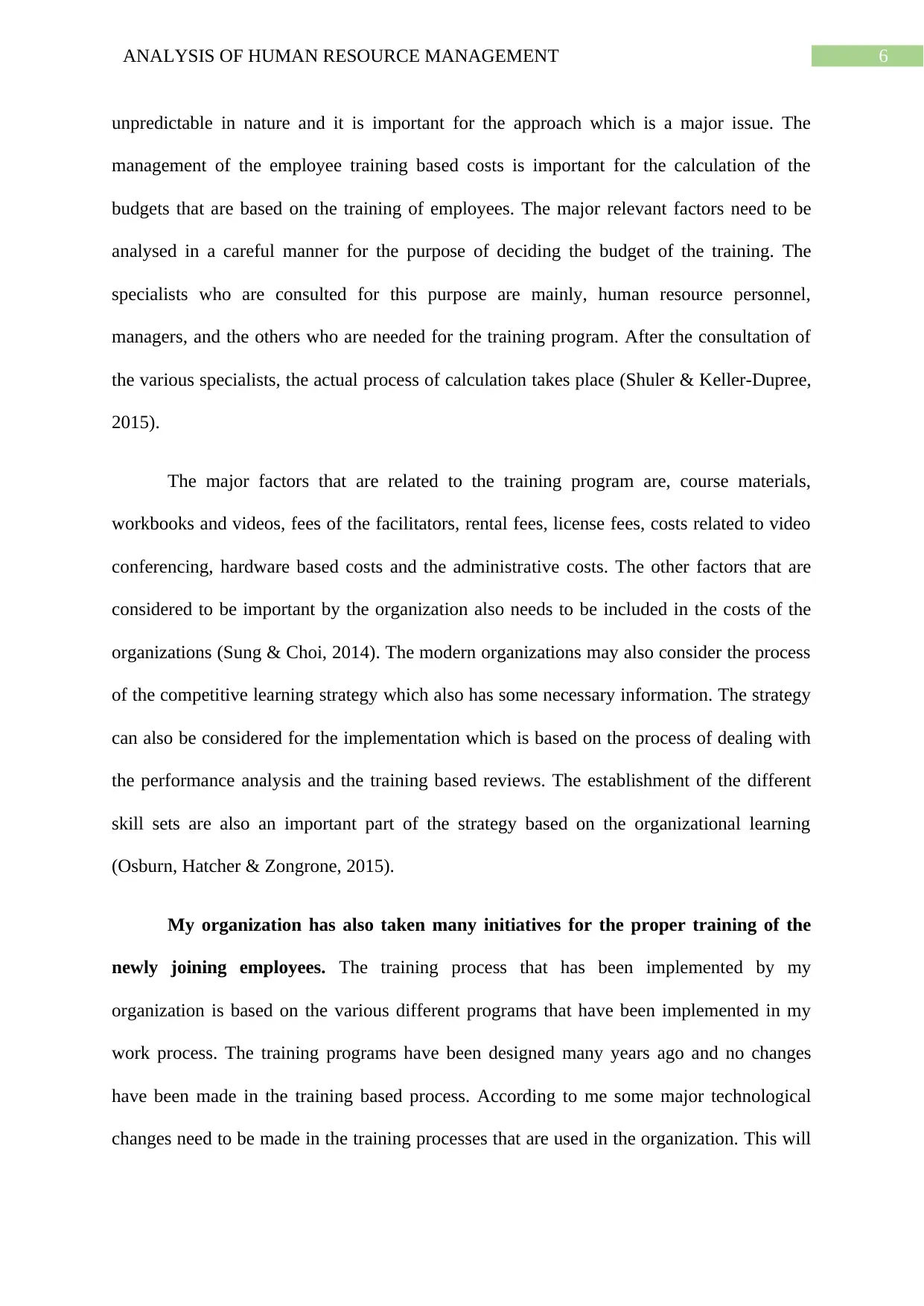
6ANALYSIS OF HUMAN RESOURCE MANAGEMENT
unpredictable in nature and it is important for the approach which is a major issue. The
management of the employee training based costs is important for the calculation of the
budgets that are based on the training of employees. The major relevant factors need to be
analysed in a careful manner for the purpose of deciding the budget of the training. The
specialists who are consulted for this purpose are mainly, human resource personnel,
managers, and the others who are needed for the training program. After the consultation of
the various specialists, the actual process of calculation takes place (Shuler & Keller-Dupree,
2015).
The major factors that are related to the training program are, course materials,
workbooks and videos, fees of the facilitators, rental fees, license fees, costs related to video
conferencing, hardware based costs and the administrative costs. The other factors that are
considered to be important by the organization also needs to be included in the costs of the
organizations (Sung & Choi, 2014). The modern organizations may also consider the process
of the competitive learning strategy which also has some necessary information. The strategy
can also be considered for the implementation which is based on the process of dealing with
the performance analysis and the training based reviews. The establishment of the different
skill sets are also an important part of the strategy based on the organizational learning
(Osburn, Hatcher & Zongrone, 2015).
My organization has also taken many initiatives for the proper training of the
newly joining employees. The training process that has been implemented by my
organization is based on the various different programs that have been implemented in my
work process. The training programs have been designed many years ago and no changes
have been made in the training based process. According to me some major technological
changes need to be made in the training processes that are used in the organization. This will
unpredictable in nature and it is important for the approach which is a major issue. The
management of the employee training based costs is important for the calculation of the
budgets that are based on the training of employees. The major relevant factors need to be
analysed in a careful manner for the purpose of deciding the budget of the training. The
specialists who are consulted for this purpose are mainly, human resource personnel,
managers, and the others who are needed for the training program. After the consultation of
the various specialists, the actual process of calculation takes place (Shuler & Keller-Dupree,
2015).
The major factors that are related to the training program are, course materials,
workbooks and videos, fees of the facilitators, rental fees, license fees, costs related to video
conferencing, hardware based costs and the administrative costs. The other factors that are
considered to be important by the organization also needs to be included in the costs of the
organizations (Sung & Choi, 2014). The modern organizations may also consider the process
of the competitive learning strategy which also has some necessary information. The strategy
can also be considered for the implementation which is based on the process of dealing with
the performance analysis and the training based reviews. The establishment of the different
skill sets are also an important part of the strategy based on the organizational learning
(Osburn, Hatcher & Zongrone, 2015).
My organization has also taken many initiatives for the proper training of the
newly joining employees. The training process that has been implemented by my
organization is based on the various different programs that have been implemented in my
work process. The training programs have been designed many years ago and no changes
have been made in the training based process. According to me some major technological
changes need to be made in the training processes that are used in the organization. This will
Paraphrase This Document
Need a fresh take? Get an instant paraphrase of this document with our AI Paraphraser
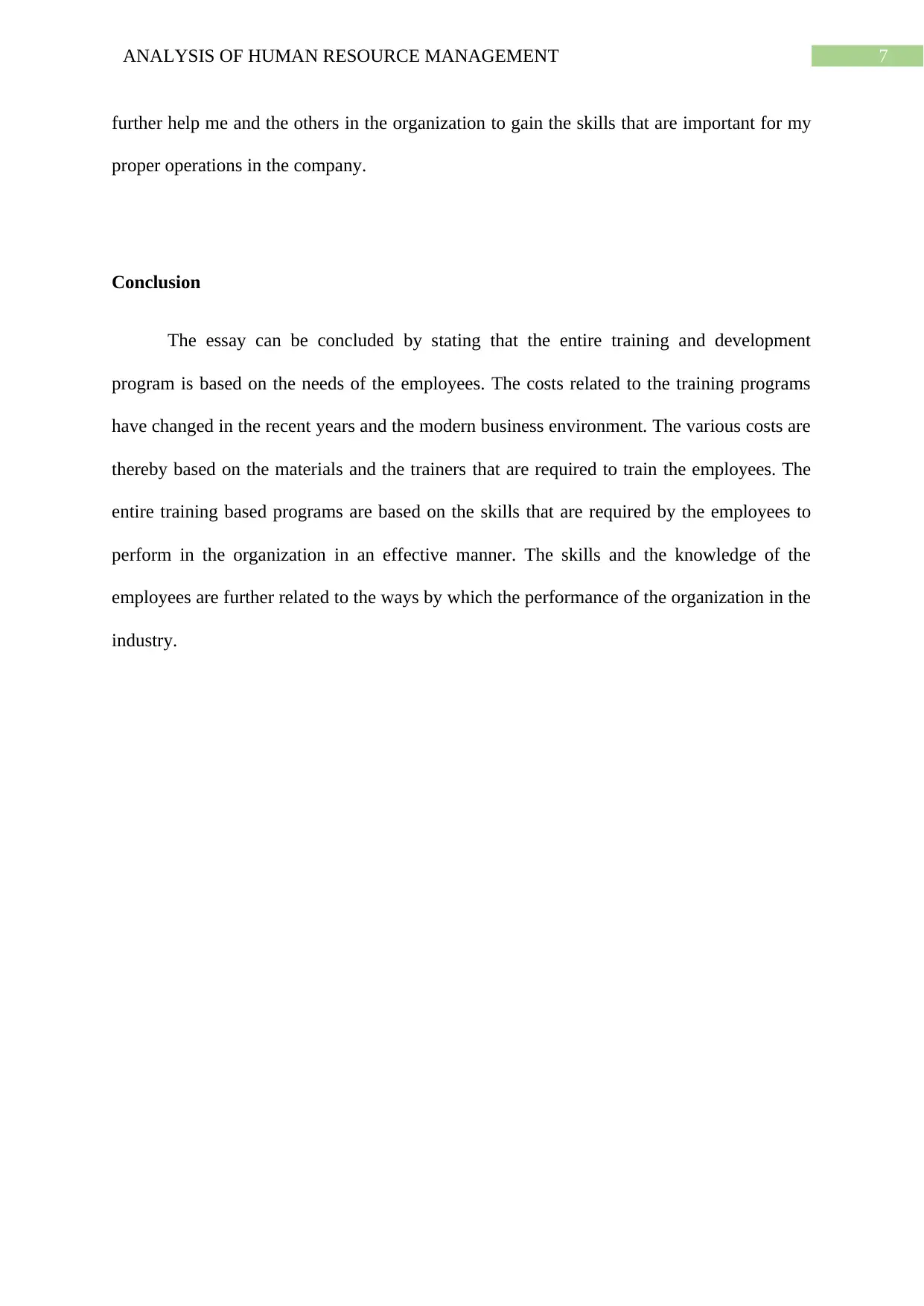
7ANALYSIS OF HUMAN RESOURCE MANAGEMENT
further help me and the others in the organization to gain the skills that are important for my
proper operations in the company.
Conclusion
The essay can be concluded by stating that the entire training and development
program is based on the needs of the employees. The costs related to the training programs
have changed in the recent years and the modern business environment. The various costs are
thereby based on the materials and the trainers that are required to train the employees. The
entire training based programs are based on the skills that are required by the employees to
perform in the organization in an effective manner. The skills and the knowledge of the
employees are further related to the ways by which the performance of the organization in the
industry.
further help me and the others in the organization to gain the skills that are important for my
proper operations in the company.
Conclusion
The essay can be concluded by stating that the entire training and development
program is based on the needs of the employees. The costs related to the training programs
have changed in the recent years and the modern business environment. The various costs are
thereby based on the materials and the trainers that are required to train the employees. The
entire training based programs are based on the skills that are required by the employees to
perform in the organization in an effective manner. The skills and the knowledge of the
employees are further related to the ways by which the performance of the organization in the
industry.
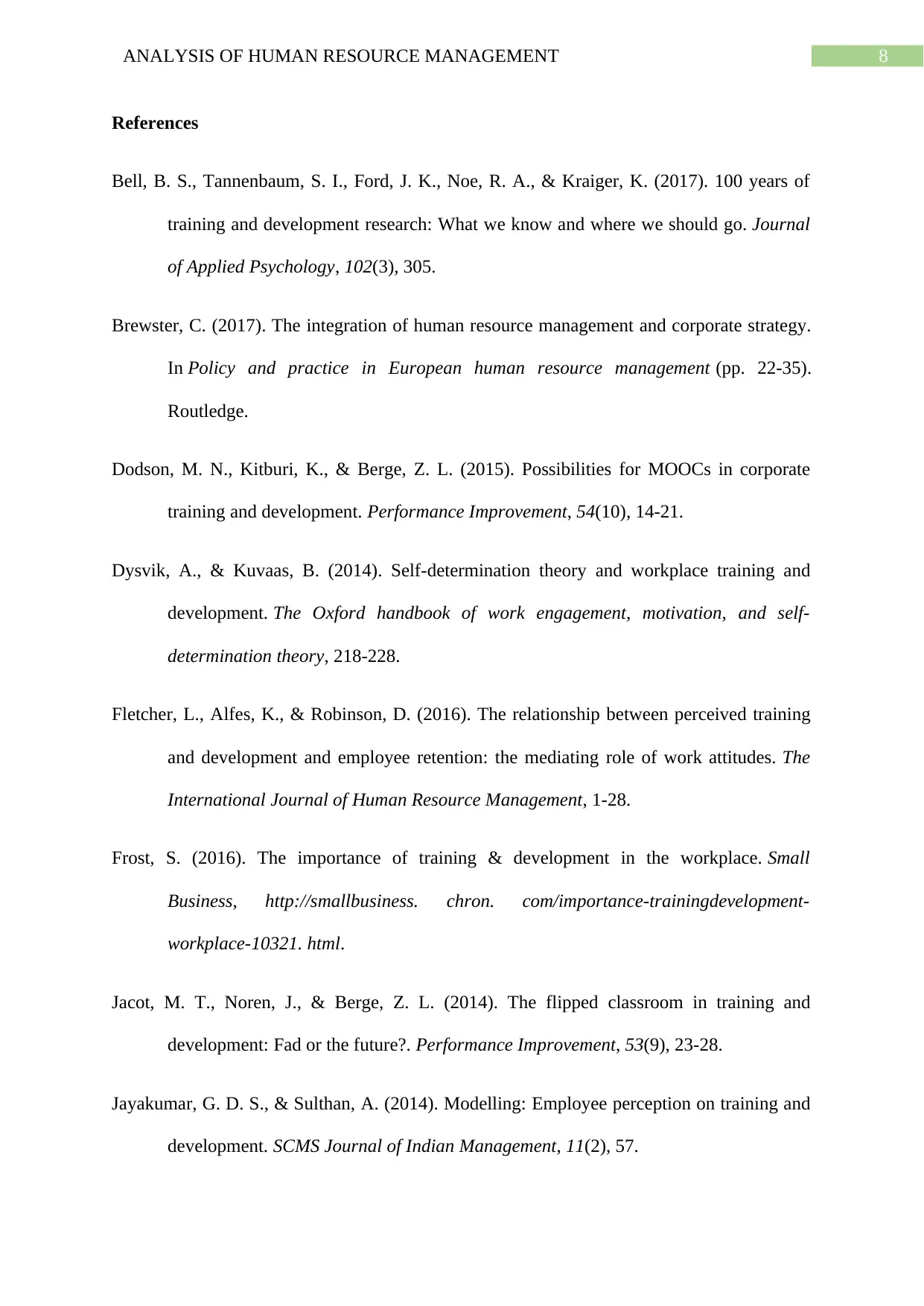
8ANALYSIS OF HUMAN RESOURCE MANAGEMENT
References
Bell, B. S., Tannenbaum, S. I., Ford, J. K., Noe, R. A., & Kraiger, K. (2017). 100 years of
training and development research: What we know and where we should go. Journal
of Applied Psychology, 102(3), 305.
Brewster, C. (2017). The integration of human resource management and corporate strategy.
In Policy and practice in European human resource management (pp. 22-35).
Routledge.
Dodson, M. N., Kitburi, K., & Berge, Z. L. (2015). Possibilities for MOOCs in corporate
training and development. Performance Improvement, 54(10), 14-21.
Dysvik, A., & Kuvaas, B. (2014). Self-determination theory and workplace training and
development. The Oxford handbook of work engagement, motivation, and self-
determination theory, 218-228.
Fletcher, L., Alfes, K., & Robinson, D. (2016). The relationship between perceived training
and development and employee retention: the mediating role of work attitudes. The
International Journal of Human Resource Management, 1-28.
Frost, S. (2016). The importance of training & development in the workplace. Small
Business, http://smallbusiness. chron. com/importance-trainingdevelopment-
workplace-10321. html.
Jacot, M. T., Noren, J., & Berge, Z. L. (2014). The flipped classroom in training and
development: Fad or the future?. Performance Improvement, 53(9), 23-28.
Jayakumar, G. D. S., & Sulthan, A. (2014). Modelling: Employee perception on training and
development. SCMS Journal of Indian Management, 11(2), 57.
References
Bell, B. S., Tannenbaum, S. I., Ford, J. K., Noe, R. A., & Kraiger, K. (2017). 100 years of
training and development research: What we know and where we should go. Journal
of Applied Psychology, 102(3), 305.
Brewster, C. (2017). The integration of human resource management and corporate strategy.
In Policy and practice in European human resource management (pp. 22-35).
Routledge.
Dodson, M. N., Kitburi, K., & Berge, Z. L. (2015). Possibilities for MOOCs in corporate
training and development. Performance Improvement, 54(10), 14-21.
Dysvik, A., & Kuvaas, B. (2014). Self-determination theory and workplace training and
development. The Oxford handbook of work engagement, motivation, and self-
determination theory, 218-228.
Fletcher, L., Alfes, K., & Robinson, D. (2016). The relationship between perceived training
and development and employee retention: the mediating role of work attitudes. The
International Journal of Human Resource Management, 1-28.
Frost, S. (2016). The importance of training & development in the workplace. Small
Business, http://smallbusiness. chron. com/importance-trainingdevelopment-
workplace-10321. html.
Jacot, M. T., Noren, J., & Berge, Z. L. (2014). The flipped classroom in training and
development: Fad or the future?. Performance Improvement, 53(9), 23-28.
Jayakumar, G. D. S., & Sulthan, A. (2014). Modelling: Employee perception on training and
development. SCMS Journal of Indian Management, 11(2), 57.
⊘ This is a preview!⊘
Do you want full access?
Subscribe today to unlock all pages.

Trusted by 1+ million students worldwide
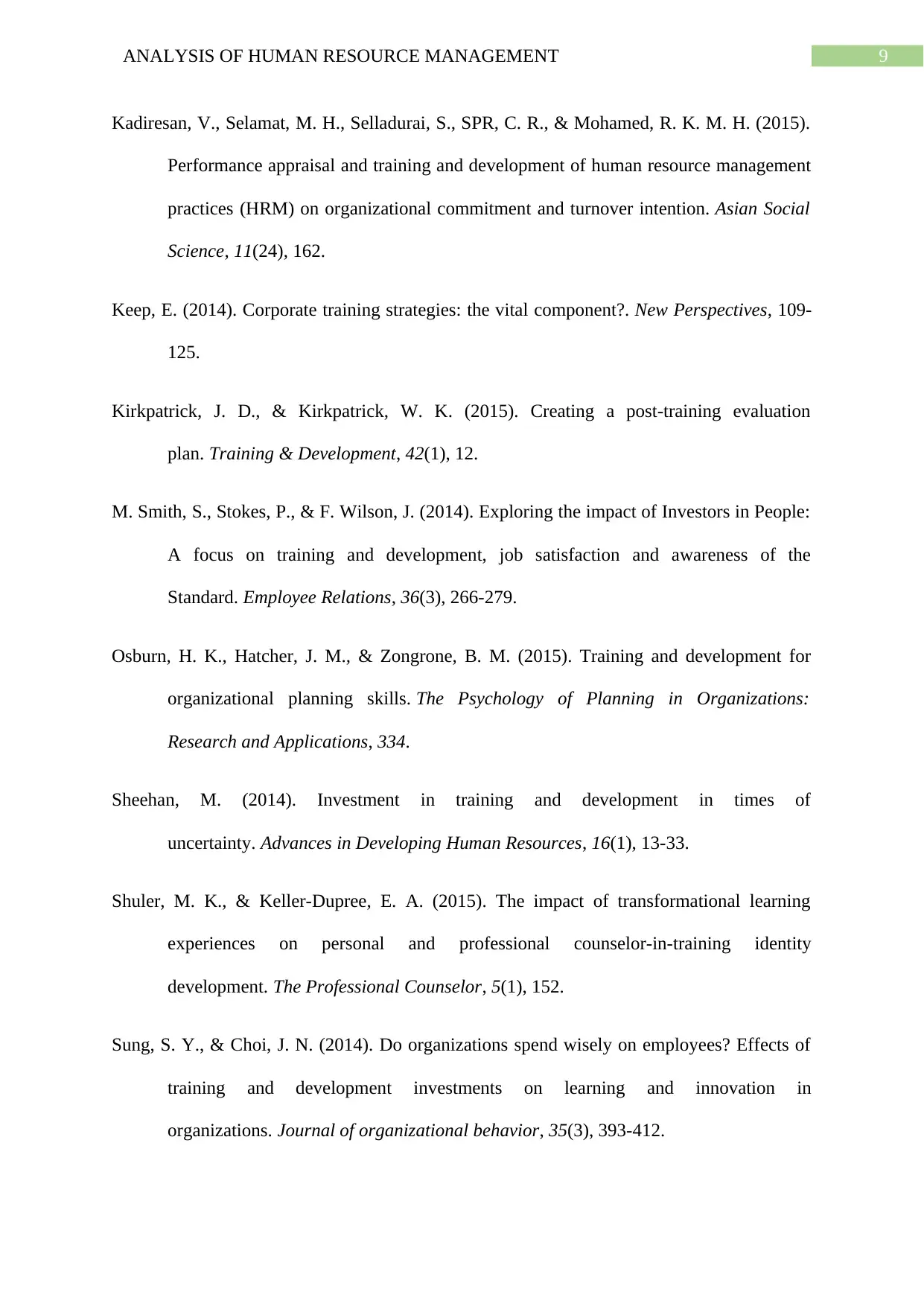
9ANALYSIS OF HUMAN RESOURCE MANAGEMENT
Kadiresan, V., Selamat, M. H., Selladurai, S., SPR, C. R., & Mohamed, R. K. M. H. (2015).
Performance appraisal and training and development of human resource management
practices (HRM) on organizational commitment and turnover intention. Asian Social
Science, 11(24), 162.
Keep, E. (2014). Corporate training strategies: the vital component?. New Perspectives, 109-
125.
Kirkpatrick, J. D., & Kirkpatrick, W. K. (2015). Creating a post-training evaluation
plan. Training & Development, 42(1), 12.
M. Smith, S., Stokes, P., & F. Wilson, J. (2014). Exploring the impact of Investors in People:
A focus on training and development, job satisfaction and awareness of the
Standard. Employee Relations, 36(3), 266-279.
Osburn, H. K., Hatcher, J. M., & Zongrone, B. M. (2015). Training and development for
organizational planning skills. The Psychology of Planning in Organizations:
Research and Applications, 334.
Sheehan, M. (2014). Investment in training and development in times of
uncertainty. Advances in Developing Human Resources, 16(1), 13-33.
Shuler, M. K., & Keller-Dupree, E. A. (2015). The impact of transformational learning
experiences on personal and professional counselor-in-training identity
development. The Professional Counselor, 5(1), 152.
Sung, S. Y., & Choi, J. N. (2014). Do organizations spend wisely on employees? Effects of
training and development investments on learning and innovation in
organizations. Journal of organizational behavior, 35(3), 393-412.
Kadiresan, V., Selamat, M. H., Selladurai, S., SPR, C. R., & Mohamed, R. K. M. H. (2015).
Performance appraisal and training and development of human resource management
practices (HRM) on organizational commitment and turnover intention. Asian Social
Science, 11(24), 162.
Keep, E. (2014). Corporate training strategies: the vital component?. New Perspectives, 109-
125.
Kirkpatrick, J. D., & Kirkpatrick, W. K. (2015). Creating a post-training evaluation
plan. Training & Development, 42(1), 12.
M. Smith, S., Stokes, P., & F. Wilson, J. (2014). Exploring the impact of Investors in People:
A focus on training and development, job satisfaction and awareness of the
Standard. Employee Relations, 36(3), 266-279.
Osburn, H. K., Hatcher, J. M., & Zongrone, B. M. (2015). Training and development for
organizational planning skills. The Psychology of Planning in Organizations:
Research and Applications, 334.
Sheehan, M. (2014). Investment in training and development in times of
uncertainty. Advances in Developing Human Resources, 16(1), 13-33.
Shuler, M. K., & Keller-Dupree, E. A. (2015). The impact of transformational learning
experiences on personal and professional counselor-in-training identity
development. The Professional Counselor, 5(1), 152.
Sung, S. Y., & Choi, J. N. (2014). Do organizations spend wisely on employees? Effects of
training and development investments on learning and innovation in
organizations. Journal of organizational behavior, 35(3), 393-412.
Paraphrase This Document
Need a fresh take? Get an instant paraphrase of this document with our AI Paraphraser

10ANALYSIS OF HUMAN RESOURCE MANAGEMENT
1 out of 11
Related Documents
Your All-in-One AI-Powered Toolkit for Academic Success.
+13062052269
info@desklib.com
Available 24*7 on WhatsApp / Email
![[object Object]](/_next/static/media/star-bottom.7253800d.svg)
Unlock your academic potential
Copyright © 2020–2025 A2Z Services. All Rights Reserved. Developed and managed by ZUCOL.





